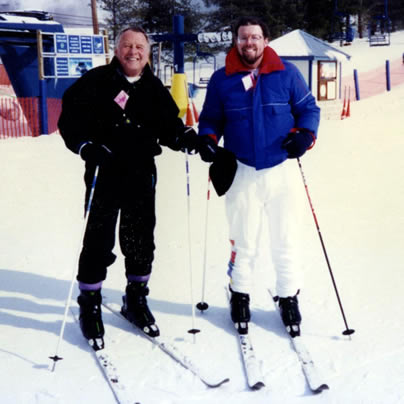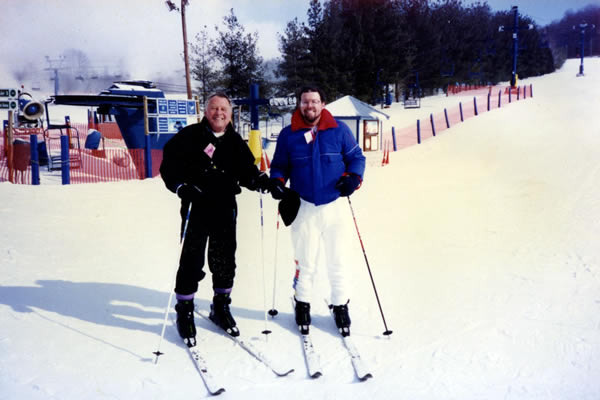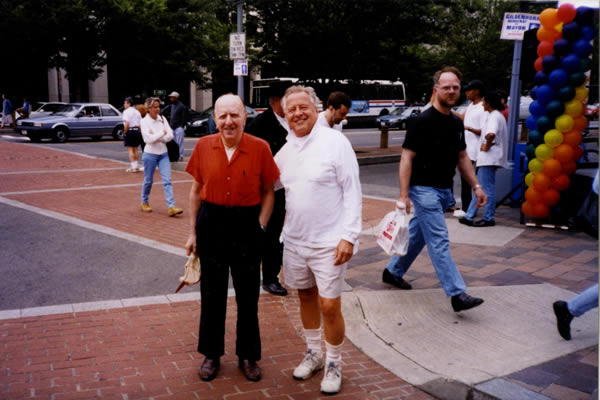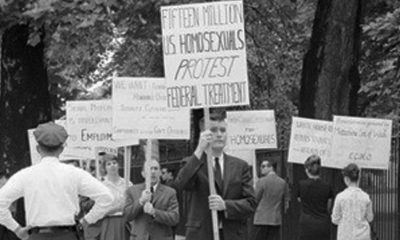Living
Labor of love
Md. man remembers late spouse, years of activism

GLEN BURNIE, Md.—Larry Esser was 25 when he met Tom Toth on his first day of work at the old Chessie System’s office in Baltimore in June 1981. The Centers for Disease Control and Prevention had just reported the first cases of what later became known as AIDS. Maryland’s anti-sodomy law was still on the books, but Toth, who was 32 years older than Esser, felt it was important to live his life as an openly gay man.
“Tom kind of pursued me, to put it quite bluntly,” Esser tells the Washington Blade during a Dec. 13 interview. “I really liked him, that’s the funny thing. I didn’t feel like he was imposing himself or anything like that … he’s the bravest person I’ve ever met. His personal courage astonished me.”
Esser stressed he “had no idea I was gay” when he met his future spouse. He grew up in what he describes as an “extremely strict Roman Catholic household” in Connecticut where he routinely heard gay people “were probably worse than murderers and they were to be avoided at all costs” and they were “mentally defective.” Esser eventually found himself in a relationship with another man he conceded wasn’t “going anywhere” when Toth finally made his move.
“He was sitting at his desk and he was singing,” Esser recalls, laughing. “It was like in a joking sort of way he was singing and the other people around him were laughing when he was doing it and he was singing something about it’s springtime and it’s time for love. The way he tells this story, I came in the door and heard him singing that and I tried to sneak away. I didn’t want any part of that. And he saw me and he said, ‘Uh oh.’ And that’s when he began to realize that I was not what he thought I was. How can you explain how two people fall in love? I can’t explain that. But it just happened. I wasn’t afraid of him personally.”
Couple’s activism starts at home
The couple routinely engaged in what Esser calls “guerrilla activism” that began when he said the railroad fired him after they began dating in 1983 because of his sexual orientation. He considered moving back to Connecticut, but Toth insisted he move into the small Glen Burnie home he shared with his then-84-year-old mother, Mary.
“There was no arguing with that,” Esser says. “The funny thing is when he said it, it was exactly what I wanted to hear, but of course I couldn’t ask him that. It was up to him to ask me, and he did. And I was delighted.”
Esser took care of Toth’s elderly mother until she died the following year. He says the same Chessy System vice president whom he claims fired him threatened to do the same to his partner once he found out they were living together. (He says the railroad in the late 1970s had tried to fire an early member of the Baltimore Gay Alliance that later became the GLBT Community Center of Baltimore and Central Maryland, but the union fought for him.)
“He couldn’t do it directly,” Esser says, recalling efforts to fire Toth, who was a unionized stenographer. “He did a bunch of different things to try to get Tom to quit. And amazingly, Tom was actually ready to resign. A woman whose name I can’t remember, but will always be grateful to her told him don’t resign because the railroad is going to do a bunch of buyouts and you’ll be able to get a lump sum payment and retire, and that’s what he did.”
The couple also for years distributed copies of the Blade at locations throughout Anne Arundel County.
They decided to approach the Anne Arundel County Public Library Board of Trustees in Annapolis in 1993 after they read about the newspaper’s threatened lawsuit against the Fairfax County (Va.) Library for its proposed ban on the publication’s distribution inside its branches. Esser said Toth was “really rough with them,” in part because “he’d gone through a very repressive time back in the 1950s.” (He lived in Manhattan for 25 years and the New York Police Department once arrested him during a gay bar raid.)
“When we got to the library board, he told them point blank, ‘You’d better do this,’” Esser says. “They were not happy. They were not happy at all. I think some of them were actually kind of sympathetic to what we wanted to do, but they were taken aback by how assertive he was. They weren’t used to that. The library board is used to people coming and requesting things, not telling them what they’re going to do. And they were not happy.”
Esser says one of the board members later told him the board did not want to meet with Toth anymore because “he was very blunt,” but in the end they granted them permission to place 15 copies of the Blade in libraries in Glen Burnie, Severna Park and Annapolis. They continued distributing the Blades each week from the Center for more than two decades.
“By putting the paper there, I always felt that, I always wondered … if a young person going by thinking they were maybe gay or knew they were gay but felt very isolated, if they saw those papers, maybe that would give them a little bit of encouragement or a little bit of reassurance. But the other point was just sheer visibility. By having those papers there, Tom used to say … if even one person picks one up, he said even if they throw them away they still got to look at them. And that was an excellent point. And he was quite right. That meant a lot to us.”
Trust the truth
The AIDS epidemic had begun to exert its toll on gay men by the time the couple began dating — Esser recalls a time both he and Toth went to a small Severna Park health clinic to get HIV tests. Toth says the nurse asked him whether he was a gay man. “He said that was the first time in his entire life anyone asked him that directly,” Esser says. “He had never been asked that question.”
Esser says he felt the atmosphere during the late 1980s was “pretty optimistic” in spite of the epidemic and late-North Carolina Sen. Jesse Helms, fundamentalist preachers Jerry Falwell and Pat Robertson and other social conservatives who sought to demonize gay men during the AIDS crisis.
“Oddly enough, Tom never disliked [then-President Ronald] Reagan, but I think that’s because he remembered him from his movie star days,” Esser says. “He felt Reagan didn’t understand the whole situation that he was dealing with AIDS and gay people. He felt that Reagan really just didn’t understand it. It’s not that he was anti-gay particularly; he just didn’t really know what he was doing … I didn’t feel so kindly to Reagan at all. I thought he was just horrible.”
Toth and Esser also became involved in the effort to add sexual orientation to Maryland’s non-discrimination law in the 1990s.
He recalls one legislator who was “really being ridiculous, saying really ugly things about us” during a hearing on the measure in Annapolis. One of this lawmaker’s colleagues who had refused to listen to his speech asked Toth and Esser how they could stand to hear his rhetoric.
“Tom said, ‘Well we know it isn’t true, so we don’t worry about it,’” Esser says. “Of course you’ve got to fight. You can’t let people say things that aren’t true and let them say it without challenging it. And Tom did that. But at the same time you can’t let it stop you. You can’t let that negativism stop you. You have to keep fighting, pushing against it and that’s what Tom really, really did.”
Esser notes that Toth’s life spanned the same period through which Frank Kameny lived — the two met during the 2000 D.C. Pride parade. And Esser says when they met, it was as if they were kindred spirits.
“They were really speaking the same language,” he says, noting both Esser and Kameny came of age in the 1950s when lobotomies were performed as a way to cure homosexuality. “It was very impressive for me being a younger person relative to them seeing what these two men must have come through and how they were both so determined to do what they were doing. They refused to back down. They refused to accept what they were being told they had to accept. They wouldn’t do it. And that was a beautiful thing to me. It’s a moment I will never forget.”
Mesothelioma that Toth developed from asbestos exposure while working at a Baltimore shipyard that built liberty ships during World War II had already taken its toll by the time Gov. Martin O’Malley signed the state’s same-sex marriage law in March.
Toth and Esser legally married in D.C. in 2010, but he wanted to vote for both Question 6 and President Obama on Election Day. He applied for an absentee ballot because he did not think he would live until Nov. 6.
It arrived in the mail in early October.
“It came and I said do you want to sign it?,” Esser, who fought leukemia at the same time his spouse struggled with mesothelioma, says. “And he said, ‘No, I’ll do it tomorrow. Well the next day he wasn’t strong enough.”
Toth died three days later — on Oct. 11 — at age 88.
“He never did sign the absentee ballot,” Esser says. “He was very aware of what was going on. He was politically interested. He definitely wanted Obama to win. We just detested Romney. The hardest thing to communicate to people who were not gay (is) how much Obama had done to us, compared to everybody else.”
Esser says Toth wondered whether history would remember Obama along the same lines as Franklin Roosevelt in terms of “what he had done, particularly for gay rights.”
“When you come from a time where you were ignored totally … and suddenly here’s the president and he’s doing all these executive orders and this happening and that’s happening and then he comes out in favor of same-sex marriage, well that’s fantastic,” Esser says. “He was just delighted.”
Related content:
Great places to get married in Maryland
Before you wed — legal considerations
Real Estate
In real estate, trust the process
With rates coming down, we could see spring surge in buyers

The average 30-year mortgage rate is falling, little by slowly. With predictions that the rate will continue to adjust downward in the next year or two, there may be a busier spring market than we have seen in the last few year, especially for the DMV market, which has been reeling from thousands of layoffs this past year. The frenzied activity resulting from interest rates close to 3% for some borrowers will probably not occur; however, this spring could add up to be a few notches busier than the last.
What does this mean for buyers and sellers? Lender Tina Del Casale with Waterstone Mortgage says she has seen “low to mid 6’s as the average for conventional loans.” If rates continue downward into the 5% range, there may be more activity than we saw in the last year or two. This could release a little bit of pent up demand.
Many buyers will have found that for whatever reason, their current home is not meeting their needs. Sellers may want to finally take the plunge and put a for sale sign in the yard and online, now that they might find a more reasonable rate on their next home. This winter can be an opportunity to assess financial situations, home conditions, and optimize one’s chances to have a sale with more agreeable terms, or put one’s best foot forward in an offer. In addition to checking with a lender or favorite handy person, let’s review what sellers and buyers typically spend their energy negotiating while enjoying the lovely process called “going under contract”:
- Timelines – Sellers might want to have their house solidly under contract (papers signed, thumbs up from the lenders, all inspection items decided upon and settled) so that they can put an offer down on a new home, and then negotiate that timeline with the other sellers. Remember, making a move is not only about the buyer taking possession of a new home, but also about the sellers figuring out their situation as well.
- Sale Price – unfortunately for buyers, in the eyes of most sellers, “money talks.” So, in a non-competitive situation, a seller might be happy to just get one offer at a price that was within the desired range. As soon as another interested buyer enters the equation, it can become a little bit like RuPaul’s Drag Race, and one will have to lip sync for one’s life, honey! And only one buyer will get to hear the words, “condragulations!”
- Tone/Vibes/Energy in the Room – Remember: Human beings are emotional creatures. All of us have feelings. And all of us want to put energy into situations where we feel appreciated, where a level of self-awareness exists, and a sense that each side is trying one’s hardest to act in good faith. The best transactions I saw were where a little grace was the “grease on the wheels” of the transaction. Occasionally, a buyer had cold feet and wanted to see the unit a few more times before the settlement date, or a seller forgot to scrub the bathroom with a little extra elbow grease before the settlement date. Life happens; misunderstandings can occur. A wise therapist once said: “You don’t have to like it, but can you allow it?” The tone of one or both parties in the transaction can be what seals the deal, or results in one party exiting the contract. (In the case of the dirty bathroom, the seller left a check with the title company for the buyer to pay a housekeeper to come clean what they couldn’t.)
Joseph Hudson is a referral agent with Metro Referrals. He can be reached at 703-587-0597 or [email protected].
Real Estate
Signs you’ve outgrown self-management of your D.C. rental
Keeping up with local regulations is a struggle

According to rental market statistics from RentCafe, Washington, D.C., remains at the top of the most popular cities for rental properties. With a strong rental market and a growing population, success should be second nature to real estate investors and rental property owners in this area.
As a self-manager of your own rental, if you’re not enjoying the profitability and the earnings that this market can provide, it might be time to look for professional management.
There are certain signs that show property owners have outgrown self-management. We’re exploring those today, and inviting DIY landlords to consider the benefits that come with a partnership with a professional property management company in Washington, D.C.
Washington, D.C., is known for having a complex and ever-changing regulatory environment. There are strict tenant rights, rent control laws, and specific rules related to property maintenance such as mold, lead based paint hazards, among others. The Rental Housing Act of 1985 is strictly enforced, and under this program, there are specific rules regarding rent adjustments, dispute resolution, and eviction protections.
Fair housing laws need complete compliance, security deposits have strict timelines, and habitability standards are in place to ensure tenants are living in a home that’s safe and well-maintained.
Staying on top of these rules can be time-consuming and difficult. Violating even a small regulation unintentionally can result in fines or legal action. It’s critical to stay compliant, and if you find yourself struggling to keep up with the evolving laws and regulations, it’s a clear sign that you may need professional help. Property managers can reduce the risk and liability of making a legal mistake.
Financial Returns are Underwhelming
A lot of self-managing landlords choose to lease, manage, and maintain their own properties because they don’t want to pay a management fee. We get it. Keeping more of your money seems like the best way to increase profitability.
But, here’s the reality of it: property managers can help you earn more and spend less on your investment, increasing your earnings and your ROI. In fact, a good property manager can often earn enough additional net revenue for the owner to pay for that fee over a year.
Property managers are experienced at maximizing the financial performance of rental properties. We can help:
- Optimize rental income
- Reduce vacancy rates
- Lower maintenance costs through established vendor relationships
- Recommend improvements for higher values
Ultimately, a good property manager will ensure that your property is being run efficiently. We will use our expertise to ensure your property is earning what it should.
Maintenance and Repairs Are Taking Up Too Much Time
Maintenance challenges are not unique to self-managing rental property owners. We deal with them, too, as professional property managers. We respond to plumbing issues and appliance malfunctions, we take calls in the middle of the night when a sewer is backing up, and we work hard to protect properties against deterioration and general wear and tear.
This can be overwhelming, especially when it comes to finding vendors and service professionals that are both affordable and provide quality service. Plumbers, electricians, HVAC technicians, and even landscapers and cleaners are in high demand in Washington, D.C. But maintenance at your rental property cannot wait. It’s essential to the value and condition of your investment as well as to the product you are selling.
It’s time to work with a professional property manager if you’re having trouble finding vendors or if you’re struggling to keep up with maintenance requests. We have systems for emergency responses, routine repairs, and preventative services.
Tenant Screening Is Becoming More Difficult and Time-Consuming
Finding good tenants is one of the most critical aspects of rental property management. But in our home of Washington, D.C. we have one of the most regulated rental markets in the country. The tenant screening process has become increasingly complex, highly restricted, and time-intensive.
Many property owners are surprised to learn that there are more limitations than ever on what can be screened, what information can be used in making a decision whom to rent to, and how screening decisions must be documented. Federal and local laws tightly regulate the use of credit histories, criminal background records, income verification, and even eviction records. Staying compliant is not optional. Failure to follow these rules can open the door to discrimination claims, administrative complaints, substantial fines, or even lawsuits.
That’s why rushing or relying on outdated methods can easily result in selecting the wrong resident or worse, unintentionally violating DC’s Human Rights Act or federal Fair Housing laws.
Problematic tenants often become evident only after move-in: lease breaks, chronic late payments, noise complaints, and property damage. When these patterns appear repeatedly, it is often a sign that the screening process is not sufficiently structured.
Why Professional Screening Matters
Professional property managers have systems in place to perform thorough, legally compliant screening while avoiding oversteps that could violate the regulations. Professional property managers use trusted screening platforms and follow written processes that keep owners protected and ensure fairness for applicants.
Columbia Property Management’s screening process includes:
- Credit Report Review
Evaluating credit patterns, payment reliability, and debt load while complying with restrictions on how data can be used. - Rental History Verification
Contacting prior landlords and reviewing national eviction databases—keeping in mind that some jurisdictions like the District of Columbia limit how far back eviction data can be seen, must less considered. - Background ChecksReviewing public records in a manner consistent with DC’s Human Rights Act and federal guidance on criminal history usage. Not all criminal records can be considered in rental decisions, and timing rules often apply.
- Income & Employment Verification
Confirming applicants can afford the rent and other monthly expenses based on their income, without ruling out certain income in a discriminatory way (e.g., vouchers, subsidies, or lawful alternative forms of income). There are many intentional steps conducted by professional property managers under a framework that ensures decisions are based on objective criteria, applied consistently, and fully aligned with the latest federal and DC regulations.
Your Property Is Sitting Vacant for Longer Periods
While current rental market dynamics are starting to show the effects of federal workforce layoffs and the worsening local economy, the vacancy rate in Washington, D.C., is relatively low, compared to the national average. According to a news report from WTOP, the local vacancy rate is just 6%, and there are an average of seven applications for every available rental unit.
A vacant rental property can quickly become a financial drain. Whether you own a condo near Dupont Circle or a single-family home in one of Capitol Hill’s neighborhoods, every day your property sits empty means lost income. While the D.C. market is generally competitive, the reality is that there are always fluctuations in demand based on seasons, neighborhood desirability, and even economic trends.
If you’re struggling to fill your rental quickly, it might be a sign that you need to re-evaluate your approach. An experienced property management company has a marketing strategy in place to keep vacancy periods as short as possible. From professional photos and listings to leveraging established networks, they can help ensure that your property is rented quickly, reducing the amount of time it sits vacant.
While managing a rental property in Washington, D.C., can be rewarding, it’s also challenging. As your property portfolio grows or the demands of your life or the demands of being a landlord increase, it’s helpful to recognize when it’s time to step back and let a professional handle the day-to-day tasks.
From navigating complex local regulations to ensuring your property remains occupied and well-maintained, there are many reasons why rental property owners in Washington, D.C., outgrow self-management. If any of these signs resonate with you, consider partnering with a property management company like ours to ensure that your rental investment continues to thrive without the stress and burnout of self-management.
We’d love to be your Washington, D.C., property management partner and resource. Please contact us at 888-857-6594 or ColumbiaPM.com
Scott Bloom is owner and Senior Property Manager, Columbia Property Management.
Advice
My federal worker husband is depressed and I don’t know how to help
I feel like he’s dragging me into his hopelessness

Dear Michael,
My husband is a federal worker. Many of his colleagues took “the fork” or have been fired. So work has been overwhelming. He usually works late. The morale in his office is terrible. His paycheck disappeared with the shutdown although due to the specifics of his job, he still had to go in. He’s gotten increasingly depressed, irritable, and short-tempered.
I met Jason 20 years ago when we were young, and one of the things that made me fall in love with him was his idealism. He came to Washington because he wanted to contribute to the well-being of our country.
When I look at him now, it’s like he’s been through the wringer. He’s lost his idealism, feels unappreciated by our country, and is becoming bitter.
He never wants to go out with friends. Either he doesn’t want to hear them complain about the same sorts of things he’s experiencing, or he doesn’t want to have to interact with people who are doing just fine, job-wise.
He also doesn’t feel like going out, just the two of us. So we’re home a lot. But we’re not spending time together when we’re at home. He’s surfing the internet, doom-scrolling, or playing video games.
I can’t get him to talk to me; he says, “I don’t want to talk about anything, it just makes me feel worse.” I can’t get him to do anything that might help him feel better. He doesn’t want to cook dinner with me, he doesn’t want to eat any of his favorite foods that I make for him, he won’t go for a walk with our dog (exercise is supposed to help mood, right?).
I’m really worried about him. Clearly, he’s depressed, and nothing I am trying is helping him to feel better.
But in addition, I am starting to get annoyed. How much more can I try to do things for him that he doesn’t respond to and doesn’t appreciate?
I’ve been OK through this long slog, so far, but now I feel like I am being sucked into his depression and hopelessness. I’m starting to feel like giving up. I’m lonely and I miss my husband and I am despairing that he’s ever really going to come back.
In short, now I hate my life, too.
I’m not going anywhere but I am worried that my main feeling toward him is starting to be apathy. Is there something I can do to help him that I haven’t thought of?
Michael replies:
I’m sorry, this is such a rough time.
It’s understandable that when someone you love is suffering and feeling miserable, you might at times get fed up and feel like pulling away.
There’s a great saying by an ancient Jewish sage, Rabbi Tarfon: While you can’t fix the whole world, that doesn’t mean you should give up and do nothing to help.
I thought of that saying as I read your letter, because while you can’t get Jason to change his mood or take action on his own behalf, you may have some ability to help him.
Similarly, while you can’t have a fantastic time in life when your husband is in a miserable place, you can take care of yourself and likely have a better life than you are having at present.
For starters, I encourage you to keep reminding yourself that this is without doubt one of the hardest periods of your husband’s life. So it’s a very good idea to have an open heart and a lot of compassion for Jason, as much of the time as you can. This won’t be easy. Strive to keep in mind that getting angry at Jason or frustrated with him won’t help.
Don’t try to insist that Jason do anything. Often, when we push someone to do something that they don’t want to do, this just results in their digging in more. People generally don’t like to be nagged.
Of course you can ask Jason if he’d like to join you for a walk, or an outing, but tread carefully. You can advocate for what you’d like, but Jason gets to decide what he wants to do.
You can certainly ask Jason what he would like from you, especially when he’s complaining. I love the “3 H’s” concept: Would he like you to hear (simply listen)? Would he like help (advice on what to do)? Or would he just like a hug?
The best message you can send to Jason, by your presence and by an ongoing loving stance, is “I am here. You’re not alone.” Even when he wants to stay in the basement playing video games. You’re not criticizing him and you’re not judging him. Maybe you’re baking some cookies you both like and leaving him a plateful to eat if and when he wants to. (Be sure to treat yourself to some, as well.)
In terms of bigger interventions, you can suggest that Jason meet with a therapist, or meet with his physician to discuss the possibility of an antidepressant to help him through this awful period. For example, you might have a sincere conversation where you say something like this:
“I’m worried about you. I really want to encourage you to get some help. My love for you can only go so far, and while I’m not going anywhere, I’d like you to take seriously how miserable you are. I’m here to encourage you that maybe you could feel better, even though your circumstances are terrible and you feel disillusioned.”
Again, trying to convince or force Jason to take action will likely go nowhere useful.
Now let’s focus on you. Living with a depressed spouse can be a miserable, soul-crushing experience. As you described, you’re watching the person you love suffer, and you’re pretty much losing your partner in so many of the things that make life enjoyable.
Part of getting through this is to acknowledge that there is a limit to what you can do for Jason. And part of it is to strengthen your commitment to self-care. Taking care of yourself may keep you from going too far into misery or resentment. He doesn’t want to get together with a friend? Consider going anyway, and do your best to have at least a good time. Same thing with a dog walk, a good meal, or sitting down to watch a movie you’d like to see. You might also consider meeting with a therapist for ongoing support and strategizing.
While this period of your life is gruelingly difficult, try to remember that it likely will come to an end, that there will likely be good times ahead for you and for Jason, and that in the meantime, doing your best to find ways to take care of yourself while also being a supportive and loving spouse will help you to survive.
Michael Radkowsky, Psy.D. is a licensed psychologist who works with couples and individuals in D.C. He can be found online at michaelradkowsky.com. All identifying information has been changed for reasons of confidentiality. Have a question? Send it to [email protected].























